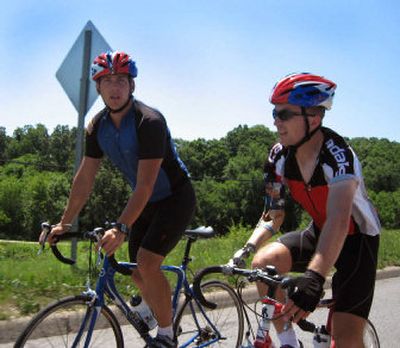Vets wounded in service bicycle across the U.S.

BRANSON, Mo. – Wake-up call is 4:30 a.m. for these soldiers, and a day of cycling as many as 100 miles on black asphalt in the hot sun lies ahead. But this is no boot camp.
These soldiers all have served in Iraq or Afghanistan and all were severely injured there. They lost legs or arms, have replaced elbows or reconstructed feet. Home from war, they have chosen to spend their summer cycling from coast to coast to raise awareness and money for other wounded veterans.
“A lot of guys feel it’s like being in the Army again,” said Staff Sgt. Yegor Bonderenko, 25, who lost his right arm in a roadside bombing south of Baghdad last year. He stands in a Cracker Barrel parking lot off the strip in this tourist town, fiddling with his bike, specially made to fit him and his injury. He cycled through the Ozark Mountains from Little Rock that morning.
“It’s a journey. It’s tough,” he said. “You’ve got to do it.”
About 80 soldiers signed up to cycle at least a portion of this summer’s Soldier Ride. Only Bonderenko and Sgt. Drew Biddle have chosen to complete all 4,400 miles from Montauk, N.Y., to San Diego. The cyclists travel with vans full of supplies and a crew that jumps to get them water or energy bars and fixes flats or grease chains.
Miles to go
Soldier Ride started with five cyclists as a fundraiser for the Wounded Warrior Project in 2003. Now it’s become so popular there are corporate sponsors. The money the soldiers raise helps other wounded veterans as they find jobs or adjust to the stresses of civilian life.
“It’s easy in our everyday lives to forget that the war is still going on a daily basis,” Soldier Ride’s executive director, Steve Nardizzi, says. “Their needs haven’t gone away just because it’s three years into these conflicts. If we don’t continue to let the American public know there’s that need, then they can’t address that need.”
So the soldiers wake early each day to beat the hot sun and ride. And every day they stop in a new town to meet other veterans. They’re treated well – a standing ovation at the Grand Ole Opry in Nashville, Tenn., seats to Major League Baseball games, free dinners. They are living examples of the costs of war and how the human spirit can endure.
“These guys,” Nardizzi said. “They’re doing something most of us with an able body wouldn’t do.”
And just what is that commitment? The soldiers are cycling Lance Armstrong-style: between 50 and 100 miles a day – day after day. They have to be at Camp Pendleton just north of San Diego by July 29.
On this day, as the riders cruised into Branson, the top headline is that the U.S. death toll in Iraq has reached 2,500 soldiers. The Soldier Riders have completed 2,000 miles.
A personal odyssey
Lena Libich-Bonderenko sees a change in her husband since he pedaled west on May 6.
“He’s talking more,” she said. “He’s maybe more open to other people, talk to the other guys.”
Bonderenko nods in agreement, looking down at his wife smiling and adds, “Everybody talks about different things. We’re all dealing with different problems we share.”
Bonderenko and his wife live in San Antonio to be near his rehabilitation center. Losing his right hand has made him learn how to do everything over again, he said. His bicycle was modified so the gears, the brakes, everything is on the left side.
“I was going to ask for a motor to power me up the hills but they wouldn’t go for that idea,” he said.
Cpl. Kevin Blanchard, 23, is riding 450 miles from Little Rock to Dallas. The Marine from Arlington, Va., lost his left leg below the knee in an explosion while on patrol last summer in Iraq. This fall he’s going to school at George Washington University in Washington, D.C., to study international business. Until then he’s keeping in shape with Soldier Ride.
“It’s been really good therapy for me physically,” he said. “It’s strengthened my legs a lot. I feel like I’m in really good shape.”
A new ‘normal’
Rob Roeder was on an aircraft carrier off the coast of Iraq on Jan. 29, 2005, when the arresting wire that’s supposed to catch the planes snapped, taking his left leg with it. He also has a replacement left elbow and a reconstructed right foot from the accident.
Ten weeks later he was walking.
“I was trying to achieve normalcy, and this is one way I can. I rode a bike before my injury,” he said. “Now I can prove to myself that I can just be normal.”
Roeder cycled 500 miles with Soldier Ride last summer. This year he’s the logistical guru.
He keeps the van filled with Gatorade, helmets and a road atlas. Having other injured soldiers around helps him deal emotionally with his injury, he said.
“You’re surrounded by guys,” he said, stopping, quiet for a minute. “Everyone else has the same problem as you.”